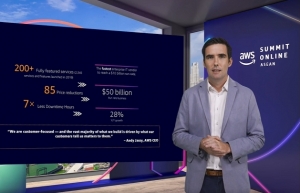Moving to AWS Cloud a chance for companies in Asia-Pacific to reduce carbon footprint
 |
| Cloud adoption |
Findings from the Carbon Reduction Opportunity of Moving to the Cloud for APAC report by 451 Research, part of S&P Global Market Intelligence, found that on average, organisations moving their business applications from on-premises data centres to cloud infrastructure in the Asia-Pacific can expect to reduce their energy use and associated carbon footprint by 78 per cent.
Furthermore, if cloud operations in the Asia-Pacific could be powered by 100 per cent renewable energy, moving compute workloads to the cloud would further boost emissions savings up to 93 per cent for average Asia-Pacific companies in a region where procuring renewable energy remains challenging. Commissioned by AWS, the study surveyed over 500 companies across the Asia-Pacific, spanning a variety of industries across Australia, India, Japan, Singapore, and South Korea.
 |
| Ken Haig, head of Energy Policy for Asia-Pacific and Japan, AWS |
“Customers in the Asia-Pacific who move compute workloads to the AWS Cloud can significantly reduce their carbon footprint, benefiting from the net effect of all our sustainability efforts,” said Ken Haig, head of Energy Policy for Asia-Pacific and Japan at AWS. “Our scale and focus on innovation allow us to improve the energy efficiency of our data centre operations faster than traditional on-premises infrastructure.”
“Asia-Pacific markets remain among the most challenging in the world for businesses seeking to source 100 per cent renewable energy but we continue to collaborate with private and public organisations to overcome these barriers and invest in more projects in the region. At AWS, we are also working closely with customers to help them meet their own sustainability goals using cloud technology and driving innovation in low carbon solutions,” the head added.
According to Kelly Morgan, research director, Datacenter Infrastructure & Services at 451 Research, hyperscale cloud data centres on average perform the same workloads at nearly five times the energy efficiency of typical Asia-Pacific enterprises and public sector organisations.
“Hyperscale cloud providers like AWS are driven to make all parts of their infrastructure work in sync to increase efficiency – from design to operations – in order to lower costs and provide IT services at scale. As digital infrastructure is not always the core business of enterprises, data centre energy costs and carbon footprint may not be top priorities. Additionally, significant barriers remain to procuring renewable energy in the Asia-Pacific. The lack of accessible and affordable corporate renewable energy options in the region leaves a significant amount of carbon reduction potential on the table,” Kelly Morgan added.
The study found that cloud-based data centres have significant efficiency advantages at both the server and facility levels. Further, it found that cloud servers are responsible for more than 67 per cent of energy reduction due to the use of advanced technology and high utilisation.
451 Research further found that facility-level efficiency gains at cloud data centres, such as advanced power distribution systems and using advanced cooling technology, account for more than 11 per cent energy efficiency gains compared to typical on-premises infrastructure.
451 Research stated that cloud providers have more aggressive renewable energy goals than many companies in Asia-Pacific, and the scale of their investments is such that each new project adds tens of megawatts of new renewable power to the grid. However, there are significant barriers to renewable energy opportunities in the Asia-Pacific, as evidenced by the relatively low number of corporate renewable power purchase agreements (PPAs) executed there to date.
According to Bloomberg New Energy Finance, as of the end of 2020, there have been only 75 corporate PPAs (totalling 4.5GW) executed to date in the Asia-Pacific region, compared to 233 in Europe (14GW) and 959 in the United States (43GW). If enabled by local energy markets to source 100 per cent renewable energy to power their operations in Asia-Pacific, cloud providers would be able to reduce the emissions of workloads run in the cloud by another 15 per cent. Combined with the server and facility level efficiency gains, this would reduce overall carbon emissions from running IT workloads in the cloud by up to 93 per cent for average Asia-Pacific organisations.
 Embrace of the cloud enabling more cost-efficient operations Embrace of the cloud enabling more cost-efficient operations |
 AWS leveraging increasing interest in cloud adoption AWS leveraging increasing interest in cloud adoption |
 AWS Partner Network enables success of partners AWS Partner Network enables success of partners |
What the stars mean:
★ Poor ★ ★ Promising ★★★ Good ★★★★ Very good ★★★★★ Exceptional
Themes: Sustainable Energy
- 16th national conference on nuclear science and technology opens in Danang
- Technology and Energy Forum 2023 to open in Quang Ninh
- Asia Clean Capital Vietnam receives backing from Swiss Investment Manager
- Amazon scales renewable energy to fight climate change
- Universal Alloy Corporation Vietnam partners with Asia Clean Capital Vietnam
Related Contents
Latest News
More News
- Heavy industries set for pilot greenhouse gas quotas (December 25, 2025 | 10:00)
- Swedfund invests in MSME growth and climate action in Vietnam (December 19, 2025 | 11:42)
- GreenYellow brings solar energy to light up remote schools in Tuyen Quang province (December 19, 2025 | 08:00)
- Charge+, Grab partner to develop EV charging network in Vietnam (December 18, 2025 | 17:11)
- Linking sci-tech and innovation to Vietnam’s net-zero future (December 18, 2025 | 14:31)
- Driving double-digit growth through green and circular transformation in Vietnam (December 17, 2025 | 09:00)
- Standard Chartered and ACCA deepen collaboration to develop Vietnam’s talent for a sustainable future (December 15, 2025 | 18:18)
- Schaeffler reports strong early output from Dong Nai solar project (December 12, 2025 | 15:16)
- Forestry conference highlights biodiversity and sustainability goals (December 09, 2025 | 13:35)
- Home Credit honoured among top 10 sustainable companies in trade and services (December 09, 2025 | 12:18)

 Tag:
Tag:























 Mobile Version
Mobile Version